NVIDIA’s GeForce GTX 460: The $200 King
by Ryan Smith on July 11, 2010 11:54 PM EST- Posted in
- GPUs
- GeForce GTX 400
- GeForce GTX 460
- NVIDIA
GF104: NVIDIA Goes Superscalar
When the complete GF100 GPU was presented to us back at CES 2010 in January, NVIDIA laid out a design that in turn had a very obvious roadmap to go with it. With GF100’s modular design, derivatives of the card would be as simple as fabricating GPUs with fewer GPCs and ROPs (at least until you got to the sub-$100 market). This is the route we expected NVIDIA to take with GF104, removing 1 or 2 GPCs to make a smaller chip.
What they threw us instead was a curveball we were not expecting.
Let’s start at a high level. On GF100, there were 4 GPCs each containing a Raster Engine and 4 SMs. In turn each SM contained 32 CUDA cores, 16 load/store units, 4 special function units, 4 texture units, 2 warp schedulers with 1 dispatch unit each, 1 Polymorph unit (containing NVIDIA’s tessellator) and then the L1 cache, registers, and other glue that brought an SM together.
NVIDIA GF100 - Full Implementation, No Disabled Logic
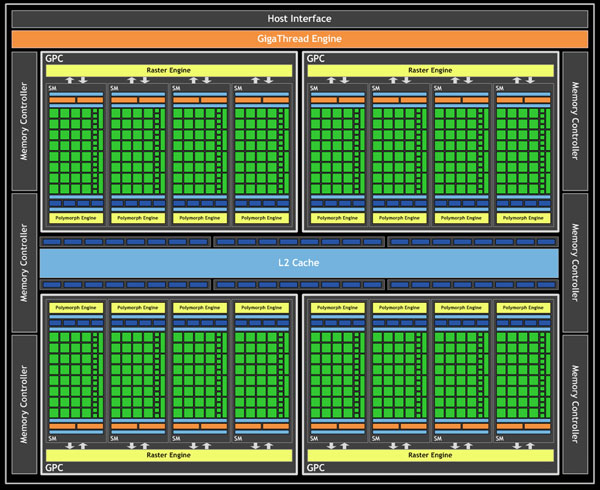
GF104 in turn contains 2 GPCs, which are effectively the same as a GF100 GPC. Each GPC contains 4 SMs and a Raster Engine. However when we get to GF104’s SMs, we find something that has all the same parts as a GF100 SM, but in much different numbers.
NVIDIA GF104 - Full Implementation, No Disabled Logic
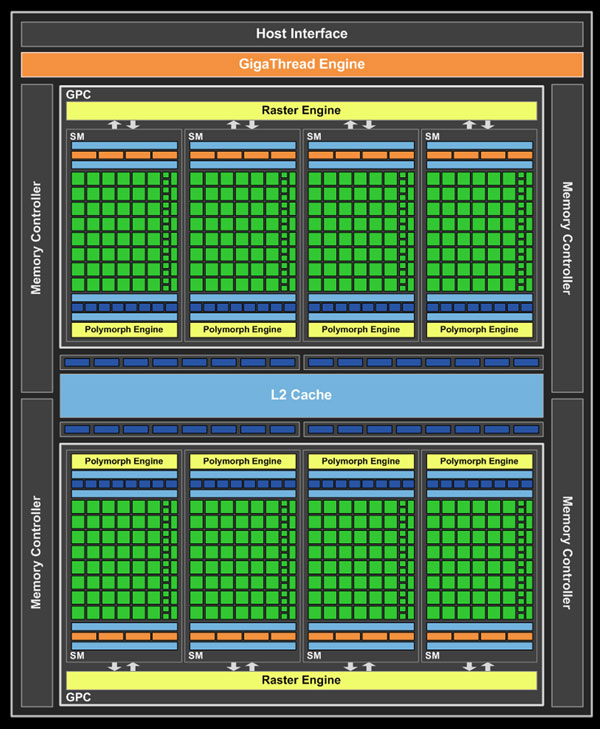
The biggest and most visible change is that NVIDIA beefed up the number of various execution units per SM. The 32 CUDA cores from GF100 are now 48 CUDA cores, while the number of SFUs went from 4 to 8 along with the texture units. As a result, per SM GF104 has more compute and more texturing power than a GF100 SM. This is how a “full” GF104 GPU has 384 CUDA cores even though it only has half the number of SMs as GF100.
One thing we haven’t discussed up until now is how an SM is internally divided up for the purposes of executing instructions. Since the introduction of G80 in 2006, the size of a warp has stayed constant at 32 threads wide. For Fermi, a warp is executed over 2 (or more) clocks of the CUDA cores – 16 threads are processed and then the other 16 threads in that warp are processed. For full SM utilization, all threads must be running the same instruction at the same time. For these reasons a SM is internally divided up in to a number of execution units that a single dispatch unit can dispatch work to:
- 16 CUDA cores (#1)
- 16 CUDA cores (#2)
- 16 Load/Store Units
- 16 Interpolation SFUs (not on NVIDIA's diagrams)
- 4 Special Function SFUs
- 4 Texture Units
With 2 warp scheduler/dispatch unit pairs in each SM, GF100 can utilize at most 2 of 6 execution units at any given time. It’s also because of the SM being divided up like this that it was possible for NVIDIA to add to it. GF104 in comparison has the following:
- 16 CUDA cores (#1)
- 16 CUDA cores (#2)
- 16 CUDA cores (#3)
- 16 Load/Store Units
- 16 Interpolation SFUs (not on NVIDIA's diagrams)
- 8 Special Function SFUs
- 8 Texture Units
This gives GF104 a total of 7 execution units, the core of which are the 3 blocks of 16 CUDA cores.
GF104 Execution Units
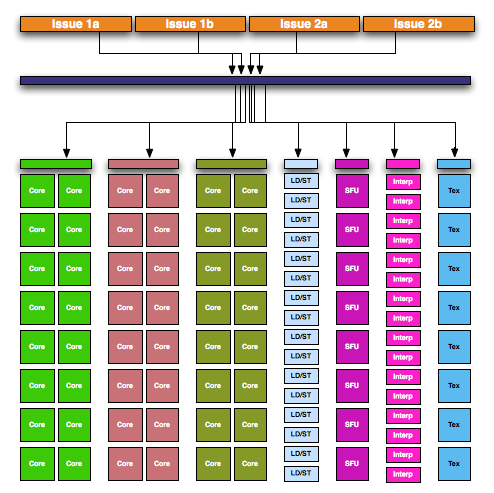
With 2 warp schedulers, GF100 could put all 32 CUDA cores to use if it had 2 warps where both required the use of CUDA cores. With GF104 this gets more complex since there are now 3 blocks of CUDA cores but still only 2 warp schedulers. So how does NVIDIA feed 3 blocks of CUDA cores with only 2 warp schedulers? They go superscalar.
In a nutshell, superscalar execution is a method of extracting Instruction Level Parallelism from a thread. If the next instruction in a thread is not dependent on the previous instruction, it can be issued to an execution unit for completion at the same time as the instruction preceding it. There are several ways to extract ILP from a workload, with superscalar operation being something that modern CPUs have used as far back as the original Pentium to improve performance. For NVIDIA however this is new – they were previously unable to use ILP and instead focused on Thread Level Parallelism (TLP) to ensure that there were enough warps to keep a GPU occupied.
NVIDIA GF100 SM
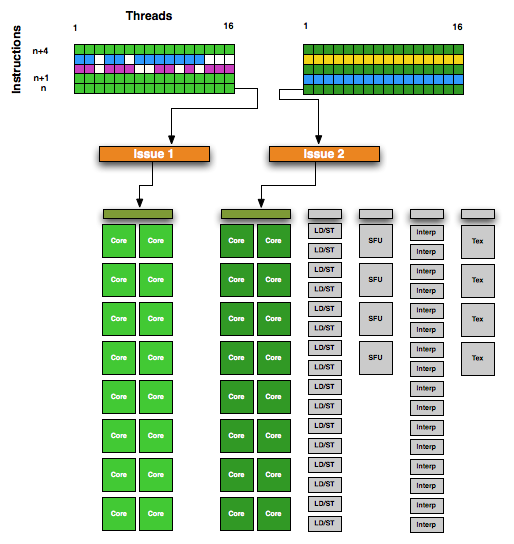
In order to facilitate superscalar operation, NVIDIA made some changes to both the warp scheduler and the dispatch unit for GF104. Each warp scheduler is now connected to 2 dispatch units, giving it the ability to dual-issue instructions. Along with its regular duties, a warp scheduler is now responsible for organizing its superscalar operation by analyzing the next instruction in its warp to determine if that instruction is ILP-safe, and whether there is an execution unit available to handle it. The result is that NVIDIA’s SMs now handle superscalar operation similar to that of a CPU, with the hardware taking the responsibility for dispatching parallel instructions. This in turn means that GF104 can execute a warp in a superscalar fashion for any code and including old CUDA code, allowing it to extract ILP out of old and new code alike. The GF104 compiler in NVIDIA’s drivers will try to organize code to better match GF104’s superscalar abilities, but it’s not critical to the ability.
NVIDIA GF104 SM - Note, more instructions in flight per SM vs. GF100
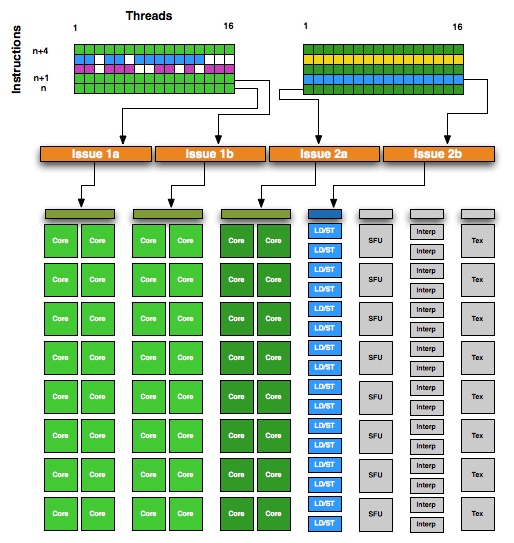
Ultimately superscalar execution serves 2 purposes on GF104: to allow it to issue instructions to the 3rd CUDA core block with only 2 warps in flight, and to improve overall efficiency. In a best-case scenario GF104 can utilize 4 of 7 execution units, while GF100 could only utilize 2 of 6 execution units.
The upside to this is that on average GF104 should be more efficient per clock than GF100, which is quite a remarkable feat. The downside to this is that now NVIDIA has a greater degree of best and worst case scenarios, as requiring superscalar execution to utilize the 3rd CUDA core block means that it’s harder to use that 3rd block than the previous 2. The ability to extract ILP from a warp will result in GF104’s compute abilities performing like a 384 CUDA core part some of the time, and like a 256 CUDA core part at other times. It will be less consistent, but on average faster than a pure 256 CUDA core part would be.
With the addition of superscalar abilities, GF104 marks the slow-but-steady merger of the CPU and the GPU. GF104 is now just a bit more CPU-like than GF100 was, a particularly interesting turn of events since we’re looking at a waterfall part and not a new architecture today.










93 Comments
View All Comments
medi01 - Tuesday, July 13, 2010 - link
It was like that some day. But now I see more and more troubling signs. iPhone dissapearing from comparison photos ("oh, I've forgotten, it should have been in my pocket") when it has huge disadvantage, but always shown where it has advantage. (and happy readers crowd not "noticing" such "unimportant detail")AMD's 5830, the 200$ card with the same "it's slower than older... but it has some features" got serious beating right in the title. (guess what, it was actually cooler than older cards, so it had one advantage more than that of nVidia). On the other hand nVidia's 200$ card that is EXACTLY in the same positoin, got PRAISED in the title.
How on earth could that be called neutral?
ViRGE - Tuesday, July 13, 2010 - link
The 5830 launched at $240, not $200. In that respect the GTX 460 is not only launching at that cheaper price, but it's faster than the 5830 (and the 4890 the 5830 failed to beat).maxpain12 - Friday, September 17, 2010 - link
I agree with Lonyo, they are simply pointing out the technical aspects of the silicon. It gives those that follow the latest and greatest developments in chip architecture some food for thought. It was never intended to mislead a customer, the performance numbers are enough evidence to give the customer a decent understanding of what to expect in the real world application of the chip in consideration.Quidam67 - Saturday, July 17, 2010 - link
You're being a bit a of a fan-boy in my opinion. The article is very well balanced. Seriously, the 460 is the first good card from nVidia in a long time, and at a genuinely afordable price. ATI finally have some real competition on their hands. Up till now they have owned this generation. And the 5830 was always an odd fit for that market sector. Really, it was just an afterthought on how to repurpose 5870 rejects. It filled a hole, but now that hole doesn't exist anymore. It's the one ATI card from this generation that I really didn't like.Zendax - Saturday, July 31, 2010 - link
When the 5830 was released there was no current generation competition, so the only point of comparison was the past generation of cards.With the 465 the obvious points of comparison are the 5830 and 5850.
I'm not going to say, resolutely, that there's zero bias, but you're clearly LOOKING for an nVidia bias, and when you go about it that way, you're guaranteed to find it.
Goty - Monday, July 12, 2010 - link
... meh.It's a decent card, but it's still months too late.
notext - Monday, July 12, 2010 - link
I agree. It is good but AMD could easily drop the 5850 down to the 1gb prices and the advantage is gone. Hopefully they will.Quidam67 - Saturday, July 17, 2010 - link
That's what I hope will happen, because at the moment my next card is going to be a GTX 460 unless the 5850 price drops a littleDominionSeraph - Monday, July 12, 2010 - link
Not all of us scour rumor sites and wait with bated breath for months for the next big thing to come out. For some of us, waiting a few months is no big deal. (especially with the lack of any "must-have" gaming titles. The heyday of PC gaming is long over.)Since the launch-price 5850's (which didn't last long), the GTX 460 seems to be the first really good buy out there. The 5770 didn't outperform the 4870, the 5830 was an overpriced turd, the price-gouged 5850's and 5870's aren't good price/performance bargains, the GTX 470 and 480 are no better and are power hogs to boot.
THIS has me excited -- especially the SLI scaling. $400-$460 in cards that'll often beat a $700 5970? And they have low idle power consumption and decent load consumption (for the performance)? I mean in that price range is the 5870, GTX 480, and 4870 x2, and GTX 460 SLI beats them all. The 5870 has much lower load power consumption going for it but it's also significantly slower.
Unless you're going to need the power of 5870 in CF, the GTX 460 seems to be the way to go.
Rekdurexu - Monday, July 12, 2010 - link
"For everything but the high-end, this year is a feature yet and not a performance year."Is that "yet" supposed to be year?